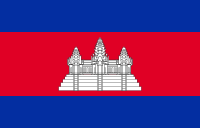 The Kingdom of Cambodia, formerly known as Kampuchea, derived from the Indian language of Sanskrit Kambujadesa (कम्बोजदेश)), is a country in Southeast Asia that borders Thailand to the west and northwest, Laos to the north, Vietnam to the east, and the Gulf of Thailand to the south. The geography of Cambodia is dominated by the Mekong River (or “the great river”) and the Tonlé Sap (“the fresh water lake”).
The Kingdom of Cambodia, formerly known as Kampuchea, derived from the Indian language of Sanskrit Kambujadesa (कम्बोजदेश)), is a country in Southeast Asia that borders Thailand to the west and northwest, Laos to the north, Vietnam to the east, and the Gulf of Thailand to the south. The geography of Cambodia is dominated by the Mekong River (or “the great river”) and the Tonlé Sap (“the fresh water lake”).
The kingdom is a constitutional monarchy with Norodom Sihamoni as king who has reigned since 2004. Phnom Penh is the kingdom’s capital and largest city, and is the center of political, commercial, industrial and cultural activities. Siem Reap, a city located near the famous ruins of Angkor Wat is the gateway to the Angkor region, and is Cambodia’s main destination for tourism. Battambang, the largest city in western Cambodia, is known for its rice production, and Sihanoukville, a coastal city, is the primary sea port and beach resort.
Cambodia has an area of 181,035 square kilometres (69,898 sq mi) and a population of over 14 million ethnic Khmer. A citizen of Cambodia is usually identified as “Cambodian” or “Khmer”, though they strictly refer to ethnic Khmers. Most Cambodians are Theravada Buddhists, but the country also have a minority number o fMuslim Cham, as well as ethnic Chinese, Vietnamese and small animist hill tribes.
Agriculture has long been the most important sector to the Cambodian economy, with around 59% of the population relying on agriculture for their livelihood (with rice being the principal crop). Other important sectors include garments, construction and tourism – foreign visitors to Angkor Wat numbered more than 4 million in 2007. In 2005, oil and natural gas deposits were found beneath Cambodia’s territorial waters, and once commercial extraction begins in 2011, the oil revenues could profoundly affect Cambodia’s economy.
Various factors contribute to Cambodian culture including Theravada Buddhism, French Colonialism, Hinduism, Angkor era culture, and modern globalization. The Cambodian Ministry of Culture and Fine Arts is responsible for promoting and developing Cambodian culture. Cambodian culture not only includes the culture of the lowland ethnic majority, the Khmer, but of also some 20 culturally distinct hill tribes colloquially known as the Khmer Loeu, a term coined by Norodom Sihanouk to generate unity between the highlanders and lowlanders.
Rural Cambodians wear a krama scarf which is a unique aspect of Cambodian clothing. Khmer culture, as developed and spread by the Khmer empire, has distinctive styles of dance, architecture and sculpture, which have been exchanged with neighbouring Laos and Thailand through the history. Angkor Wat (Angkor means “city” and Wat “temple”) is the best preserved example of Khmer architecture from the Angkorian era and hundreds of other temples have been discovered in and around the region.
Cambodia is one of the world’s poorer nations, although its economy has recovered significantly from the effects of the civil war that racked the country during the latter part of the 20th cent. Conditions are ideal for the cultivation of rice, by far the country’s chief crop. Livestock raising (cattle, buffalo, poultry, and hogs) and extensive fishing supplement the diet. Corn, vegetables, cashews, tapioca, peanuts, tobacco, cotton, and sugar palms are widely cultivated.
Rice and rubber historically were the principal exports of Cambodia, but exports fell sharply after the onset (1970) of the civil war, which put most of the rubber plantations out of operation. By the 1990s, however, rubber plantings had been undertaken as part of a national recovery program, and rubber and rice were again being exported. The fishing industry also has revived, but some food shortages continue.
Until recently, inadequate transportation hampered exploitation of the country’s vast forests, but by the mid-1990s timber had become a major export. Mineral resources are not abundant, but phosphate rock, limestone, semiprecious stones, and salt support important local mining operations. Garment manufacturing for export is now an extremely important economically; many of the country’s other industries are based on the the processing of rubber and agricultural, fish, and timber products. Tourism also contributes significantly to the economy.
Notes from Wikipedia and Answers.com









